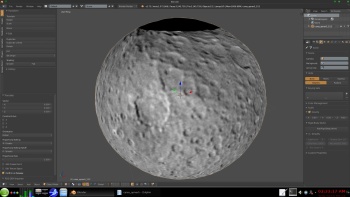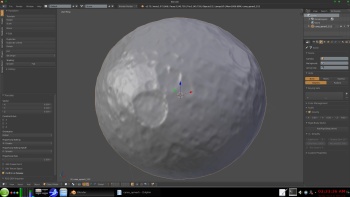Dawn approaches Ceres, From opnav images to first orbit |

  |
Dawn approaches Ceres, From opnav images to first orbit |
 Mar 8 2015, 11:59 PM Mar 8 2015, 11:59 PM
Post
#676
|
|
 Member    Group: Members Posts: 714 Joined: 3-January 08 Member No.: 3995 |
|
|
|
|
 Mar 10 2015, 08:15 AM Mar 10 2015, 08:15 AM
Post
#677
|
|
 Member    Group: Members Posts: 714 Joined: 3-January 08 Member No.: 3995 |
|
|
|
|
 Mar 12 2015, 01:00 PM Mar 12 2015, 01:00 PM
Post
#678
|
|
|
Member    Group: Members Posts: 107 Joined: 1-August 14 Member No.: 7227 |
This thread can be closed in favour of thread about Ceres orbiting: http://www.unmannedspaceflight.com/index.p...mp;#entry218672
This would improve forum readibility. ADMIN NOTE: Determining when threads are closed or new topics started throughout an ongoing mission is decided by the Forum's administration/moderation team members. Closing a thread generally only happens if a discussion becomes a serious problem to moderate or the topic is outside of the Forum's scope. We generally don't close a topic because a certain phase of the mission has come to an end. This is because new information can come to hand or updated image data is released via the PDS or similar system, that can be used to update a topic at a later point. Please note that if members have a suggestion about changes to a topic, then they can make them directly to an admin/mod at any time via the direct message system, rather than adding 'noise' to the actual discussion which reduces its readability. |
|
|
|
 Mar 15 2015, 07:23 AM Mar 15 2015, 07:23 AM
Post
#679
|
|
|
Member    Group: Members Posts: 890 Joined: 18-November 08 Member No.: 4489 |
PDS has a shape file
ftp://naif.jpl.nasa.gov/pub/naif/DAWN/misc/ceres/   hipass of the baked dem ( 0 to 360 mapping) 
|
|
|
|
 Mar 16 2015, 03:38 PM Mar 16 2015, 03:38 PM
Post
#680
|
||
 Member    Group: Members Posts: 656 Joined: 20-April 05 From: League City, Texas Member No.: 285 |
For anyone comfortable with R, here is some R code to read and view the shape files -- it will open a window with an interactive 3D viewer of the shape data, allowing you to use the mouse and mouse wheel to rotate or zoom the data. For context, I have it also plotting the X, Y, and Z axes in red, green, and blue (respectively); blue should be the North-South axis.
To use it, you'll need to have R installed (or RStudio, which is my preference). Once R is installed, install the rgl package. Extract the downloaded shape files within a directory of your choice, then you can use the following code to view the shape file in R: #BEGIN R CODE... #Run this line once. Specify the directory where the shape files (such as "ceres_opnav5_128.txt") are stored setwd("C:\\Downloads\\Ceres3D") #Run the next block once (imports the rgl library, defines functions) #BEGIN... library(rgl) #Given filename, reads shape file #Returns list containing N=#vertices, M=#plates, vertices as N-row X 3-col matrix # (1 vertex per row, each vertex being an x,y,z coordinate), # plates as M-row X 3-col matrix (each row being a vector containing the 3 vertex integer indices # defining the corners of a triangular plate, listed by convention in CCW order) ReadShapeFile<-function(filename) { N=scan(filename,n=1,what=integer()) vertsM=matrix(scan(filename,n=4*N,skip=1),byrow=TRUE,nrow=N,ncol=4)[,-1] M=scan(filename,n=1,what=integer(),skip=1+N) platesM=matrix(scan(filename,n=4*M,what=integer(),skip=1+N+1),byrow=TRUE,nrow=M, ncol=4)[,-1] list(N,M,vertsM,platesM) } MyView3D<-function() { sFileName=file.choose() shape=ReadShapeFile(sFileName) open3d() par3d(windowRect=c(100, 100, 600, 600)) rgl.pop(type="lights") rgl.light(theta=-60,phi=0,ambient="#010101",specular="#000000",diffuse="#CFCFCF") bg3d("slategray") material3d(col = "black") rgl.triangles(shape[[3]][as.vector(t(shape[[4]])),],col="grey") rgl.lines(c(-510,510),c(0,0),c(0,0),col="red") rgl.lines(c(0,0),c(-510,510),c(0,0),col="green") rgl.lines(c(0,0),c(0,0),c(-510,510),col="blue") } #....END #Run the next line each time you want to view a 3D shape file MyView3D() #To save a snapshot of the current view, set the filename and run the following line FileTitle="ThisFileName" rgl.snapshot(file=paste(paste(FileTitle,".png"),sep="")) #...END R CODE And here's an example of what you'll see when you get it working: You can also resize or maximize the window (it defaults to a smallish size). These shape files may strain your system -- I'm using a 64-bit computer with 32G of ram, and having no difficulties. Your mileage may vary. |
|
|
|
||
 Mar 16 2015, 09:00 PM Mar 16 2015, 09:00 PM
Post
#681
|
|
|
Solar System Cartographer     Group: Members Posts: 10153 Joined: 5-April 05 From: Canada Member No.: 227 |
A nice new thing at LPSC - a map of Ceres in false colour using the RC1 images - yes, that was multispectral. There's a lot of variation across longitudes. Nothing released officially yet, of course. This was on a poster.
Phil -------------------- ... because the Solar System ain't gonna map itself.
Also to be found posting similar content on https://mastodon.social/@PhilStooke Maps for download (free PD: https://upload.wikimedia.org/wikipedia/comm...Cartography.pdf NOTE: everything created by me which I post on UMSF is considered to be in the public domain (NOT CC, public domain) |
|
|
|
 Mar 17 2015, 09:06 AM Mar 17 2015, 09:06 AM
Post
#682
|
|
|
Junior Member   Group: Members Posts: 27 Joined: 2-December 14 Member No.: 7359 |
From the 46th Lunar and Planetary Science Conference :
http://www.hou.usra.edu/meetings/lpsc2015/pdf/sess630.pdf |
|
|
|
 Mar 17 2015, 11:13 AM Mar 17 2015, 11:13 AM
Post
#683
|
|
 Member    Group: Members Posts: 423 Joined: 13-November 14 From: Norway Member No.: 7310 |
The Sander crater on Mercury contains very bright hollows in a way that reminded me about the brightest spots on Ceres:
 High resolution views of the crater can be found here: [1] [2] (the image above was cropped from here) -------------------- |
|
|
|
 Mar 17 2015, 02:38 PM Mar 17 2015, 02:38 PM
Post
#684
|
|
 Member    Group: Members Posts: 423 Joined: 13-November 14 From: Norway Member No.: 7310 |
Some interesting yet confusing tweets from the LPSC:
QUOTE #LPSC2015 #Ceres Bright spot in center of basin, seen even above rim, so believe it's outgassing (needs higher res to get spectral info) https://twitter.com/Laurent_Montesi/status/...830420697387008 QUOTE Icy plume possibly seen on limb of Ceres. Exciting! #LPSC2015 https://twitter.com/MonicaGrady/status/577830943995621376 Is this based on RC2 observations, or OpNav 4-5? I got the impression from the press conference where the RC2 rotation animation was presented that cryovolcanism was low on the list for possible explanations for the brightest spots - and now it suddenly ranks high again? -------------------- |
|
|
|
 Mar 17 2015, 03:10 PM Mar 17 2015, 03:10 PM
Post
#685
|
|
|
Junior Member   Group: Members Posts: 95 Joined: 5-September 07 Member No.: 3662 |
|
|
|
|
 Mar 17 2015, 03:28 PM Mar 17 2015, 03:28 PM
Post
#686
|
|
 Member    Group: Members Posts: 495 Joined: 12-February 12 Member No.: 6336 |
Some interesting yet confusing tweets from the LPSC: Is this based on RC2 observations, or OpNav 4-5? I got the impression from the press conference where the RC2 rotation animation was presented that cryovolcanism was low on the list for possible explanations for the brightest spots - and now it suddenly ranks high again? I think this reflect different ideas and opinions among different people. There might even be one or two who is like me - though I am certainly not a planetary scientist - who look into a problem from several different perspectives in a single month. The first tweet go a reply with the alternative explanation that: "'''its a granite compounded with ice , a remnant of impact object of the crater." My best guess is that the idea is based on that image used in the rotation where the bright spot stayed very bright even on the terminator. So what we're seeing in those tweets is an ongoing debate on how to interpret what we've seen at moderate resolution. |
|
|
|
 Mar 17 2015, 06:13 PM Mar 17 2015, 06:13 PM
Post
#687
|
||
|
Junior Member   Group: Members Posts: 48 Joined: 20-December 14 Member No.: 7370 |
Some interesting yet confusing tweets from the LPSC: https://twitter.com/Laurent_Montesi/status/...830420697387008 https://twitter.com/MonicaGrady/status/577830943995621376 Is this based on RC2 observations, or OpNav 4-5? I got the impression from the press conference where the RC2 rotation animation was presented that cryovolcanism was low on the list for possible explanations for the brightest spots - and now it suddenly ranks high again? I wonder what they are referring to - it's quite a couple tweets! I took look at the white spot picts again to see any possible plume pixels and the only thing I can see is these 5 pixels (yellow circle in inset image). However if you align it to the previous frame in the rotation movie (the main image), I think they correspond to the high point of the crater rim (yellow arrow). Note, I have cranked up the exposure to max to bring out the dim pixels. |
|
|
|
||
 Mar 17 2015, 06:40 PM Mar 17 2015, 06:40 PM
Post
#688
|
|
|
Senior Member     Group: Members Posts: 3516 Joined: 4-November 05 From: North Wales Member No.: 542 |
Monica Grady refers to a feature seen on the limb rather than the terminator so maybe those aren't the right images to look in??
|
|
|
|
 Mar 17 2015, 07:13 PM Mar 17 2015, 07:13 PM
Post
#689
|
|
 Member    Group: Members Posts: 714 Joined: 3-January 08 Member No.: 3995 |
Monica Grady refers to a feature seen on the limb rather than the terminator so maybe those aren't the right images to look in?? That could explain why a few frames -- including one or two with the bright spot on the limb -- were left out of the released rotation sequence. |
|
|
|
 Mar 17 2015, 10:41 PM Mar 17 2015, 10:41 PM
Post
#690
|
|
|
Member    Group: Members Posts: 813 Joined: 29-December 05 From: NE Oh, USA Member No.: 627 |
A bit more detail on what was presented at LPSC regarding white spots...
Bright spots on Ceres could be active ice http://www.nature.com/news/bright-spots-on...=TWT_NatureNews The pictures reveal the spots even when they are near the edge of Ceres, when the sides of the impact crater would normally block the view of anything confined to the bottom. The fact that something is visible at all suggests that the feature must rise relatively high above the surface. "What is amazing is that you can see the feature while the rim is still in the line of sight,” said Andreas Nathues, a planetary scientist at the Max Planck Institute for Solar System Research in Göttingen, Germany." Craig |
|
|
|
  |

|
Lo-Fi Version | Time is now: 28th April 2024 - 04:30 PM |
|
RULES AND GUIDELINES Please read the Forum Rules and Guidelines before posting. IMAGE COPYRIGHT |
OPINIONS AND MODERATION Opinions expressed on UnmannedSpaceflight.com are those of the individual posters and do not necessarily reflect the opinions of UnmannedSpaceflight.com or The Planetary Society. The all-volunteer UnmannedSpaceflight.com moderation team is wholly independent of The Planetary Society. The Planetary Society has no influence over decisions made by the UnmannedSpaceflight.com moderators. |
SUPPORT THE FORUM Unmannedspaceflight.com is funded by the Planetary Society. Please consider supporting our work and many other projects by donating to the Society or becoming a member. |

|